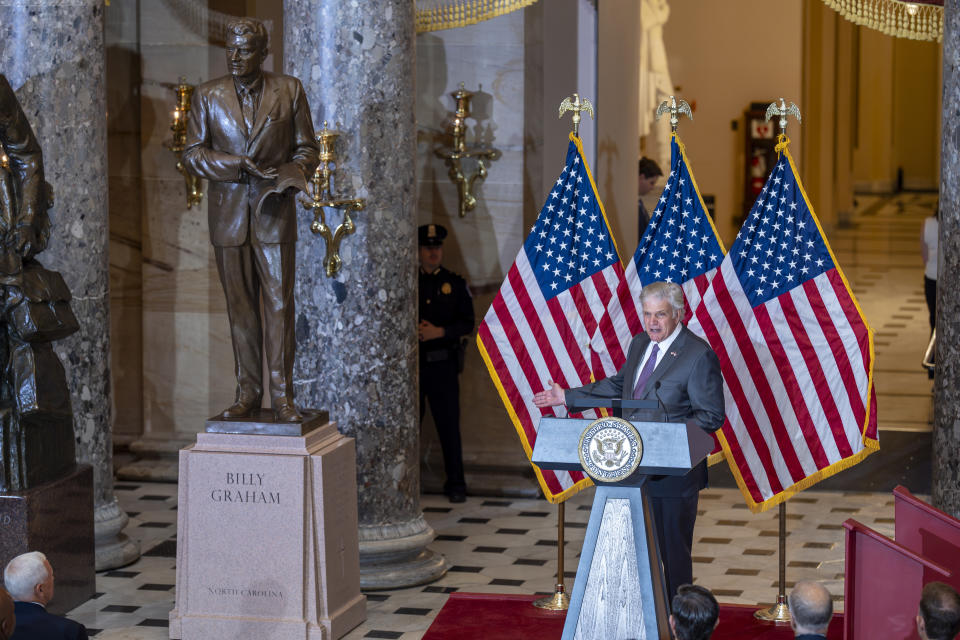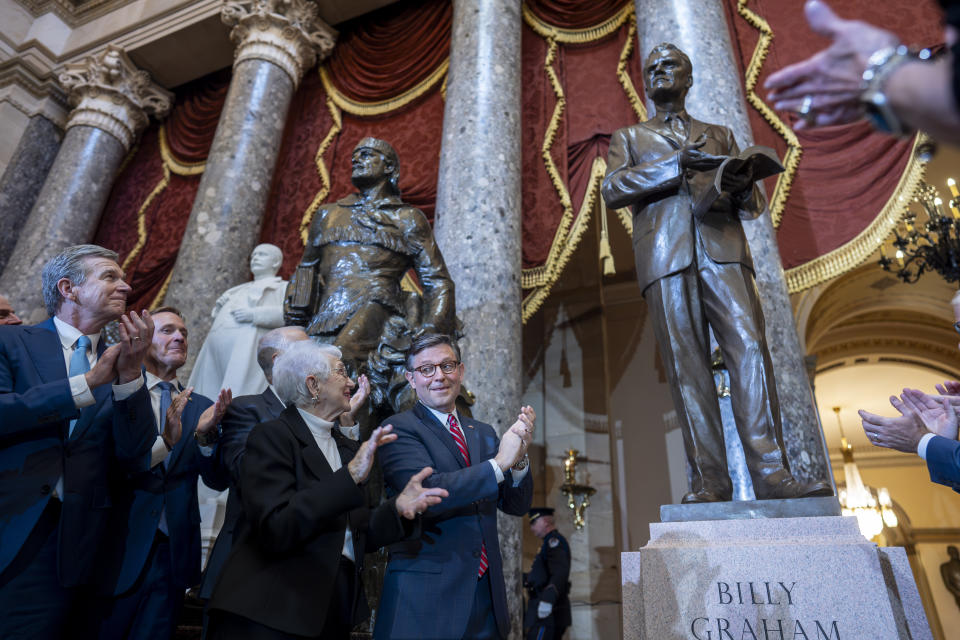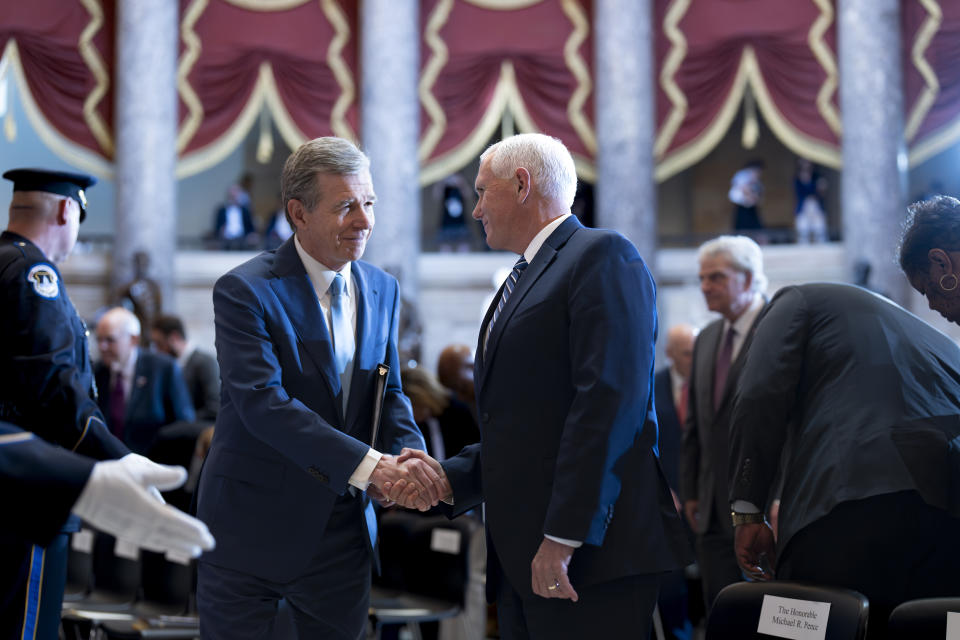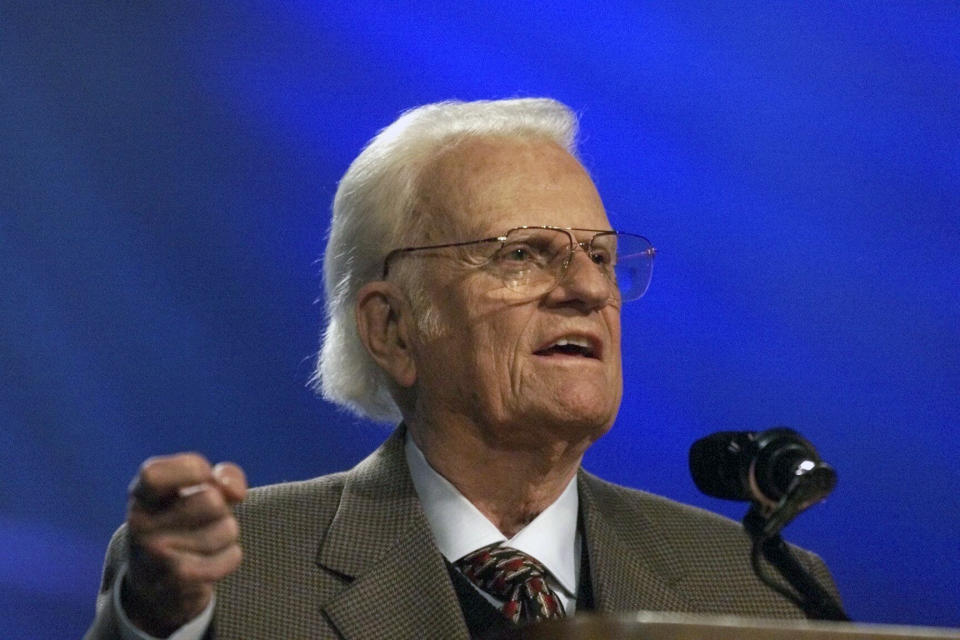The late Rev. Billy Graham is immortalized in a statue unveiled at the US Capitol
A bronze sculpture of the late Rev. Billy Graham was unveiled at the U.S. Capitol on Thursday, with Christianity's most prolific evangelist once known as “America’s Pastor” immortalized in the halls of Congress on behalf of his native North Carolina.
Graham's likeness, depicting the Charlotte-born minister with his archetypal gesture toward an open Bible in his hand, was revealed inside National Statuary Hall during a gathering attended by House Speaker Mike Johnson, Gov. Roy Cooper, former Vice President Mike Pence, state congressional and legislative members and Graham's family.
The 7-foot (2.13-meter) tall statue is one of two that North Carolina and each state get to place on display inside the hall or elsewhere in the Capitol to honor notables in their history. The process for Graham's statue to replace one of North Carolina's began nine years ago.
“Billy Graham finally takes his rightful place on these hallowed grounds of American democracy,” Johnson, a Republican from Louisiana said at the dedication ceremony. As with other speakers, Johnson recalled the personal importance that Graham’s ministry of preaching the Christian gospel had on them and their families: “Billy Graham is such a towering figure in my life, and he is in all of our lives.”
Graham, who lived most of his adult life in the mountain community of Montreat, died in 2018 at age 99. Graham was the most widely heard Christian evangelist in history, preaching in person to nearly 215 million people worldwide, according to the Billy Graham Evangelistic Association. His last large-scale meetings, known as crusades, were held in New York in 2005.
An adviser of presidents from Dwight Eisenhower to George W. Bush, Graham influenced both the political and spiritual realm during his ministry career. As a symbol of that nexus, Graham’s body had lied in honor in the Capitol Rotunda after his death, marking just the fourth private citizen at that time to receive the distinction.
The North Carolina General Assembly approved legislation in 2015 asking a congressional committee to eventually approve a likeness of Graham for display in the hall. Rules say a person’s statue can only be installed posthumously.
Ceremony speakers focused on Graham’s commitment to preaching the Christian message, his humility and integrity, and a legacy of service for future generations.
The Rev. Franklin Graham, the evangelist's son, said his father would have been a little uncomfortable with all of the attention had he been there Thursday "because he would want the focus to be on the one that he preached. He’d want the focus to be on the Lord Jesus Christ."
The Graham statue replaces one of early 20th-century North Carolina Gov. Charles Aycock, who, while known as an education advocate, has fallen from favor because of his ties to the white supremacy movement at the time.
While not a social activist, Graham integrated his Southern crusades in 1953, a year before the Supreme Court’s school integration ruling. And he long refused to visit South Africa while its white regime insisted on racially segregated meetings. Graham said later in life that he regretted that he didn’t battle for civil rights more forcefully.
“We acknowledge that he is a better representation of our state than the statue it replaces, which brought memories of a painful history of racism,” said Cooper, a Democrat, who recalled hearing Graham as a youth at a Raleigh stadium. “Not that Rev. Graham was perfect. He would have been the first to tell us that ... but he believed, as many of us do, that there is redemption."
The Graham sculpture was created by Charlotte-based artist Chas Fagan and bronzed in the state. The base, also created from local granite, is inscribed with two verses from the Book of John that highlight Graham's evangelistic ministry.
The other North Carolina statue commissioned for the National Statuary Hall is a likeness of Civil War-era Gov. Zebulon Vance, who was also a Confederate military officer and U.S. senator.
Graham helped build evangelicalism into a force in American life during the 20th century while forging powerful connections to Christian believers worldwide, including those in communist countries. His ministry was marked by the use of mass media, including a daily newspaper column, network radio and prime-time telecasts of his crusades.
U.S. Sen. Thom Tillis, a Republican from North Carolina, said that he hopes that Graham's ability to bridge differences will filter down today to elected officials.
“I hope when members of Congress walk by his statue, they reflect on the standards of faith, ethics and decency that he exemplified throughout his extraordinary life,” Tillis said. “I believe that his presence here in the Capitol can help us find opportunities to unite around what makes our nation great.”






